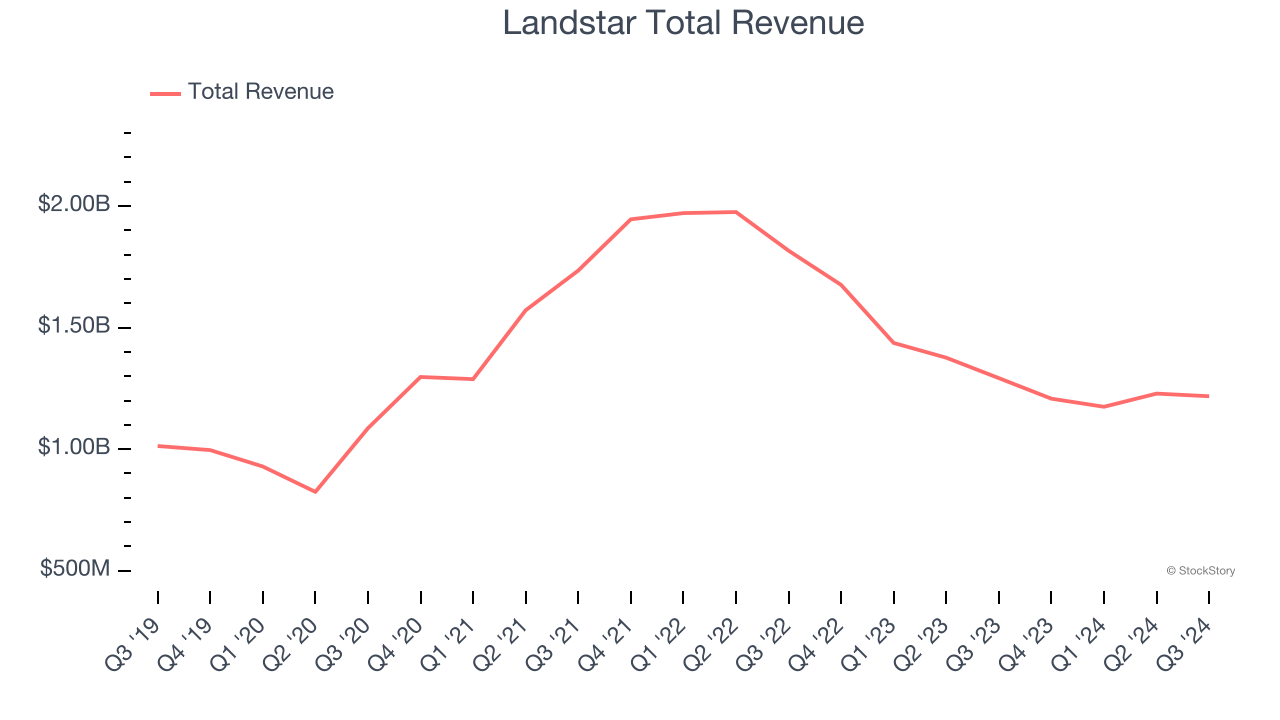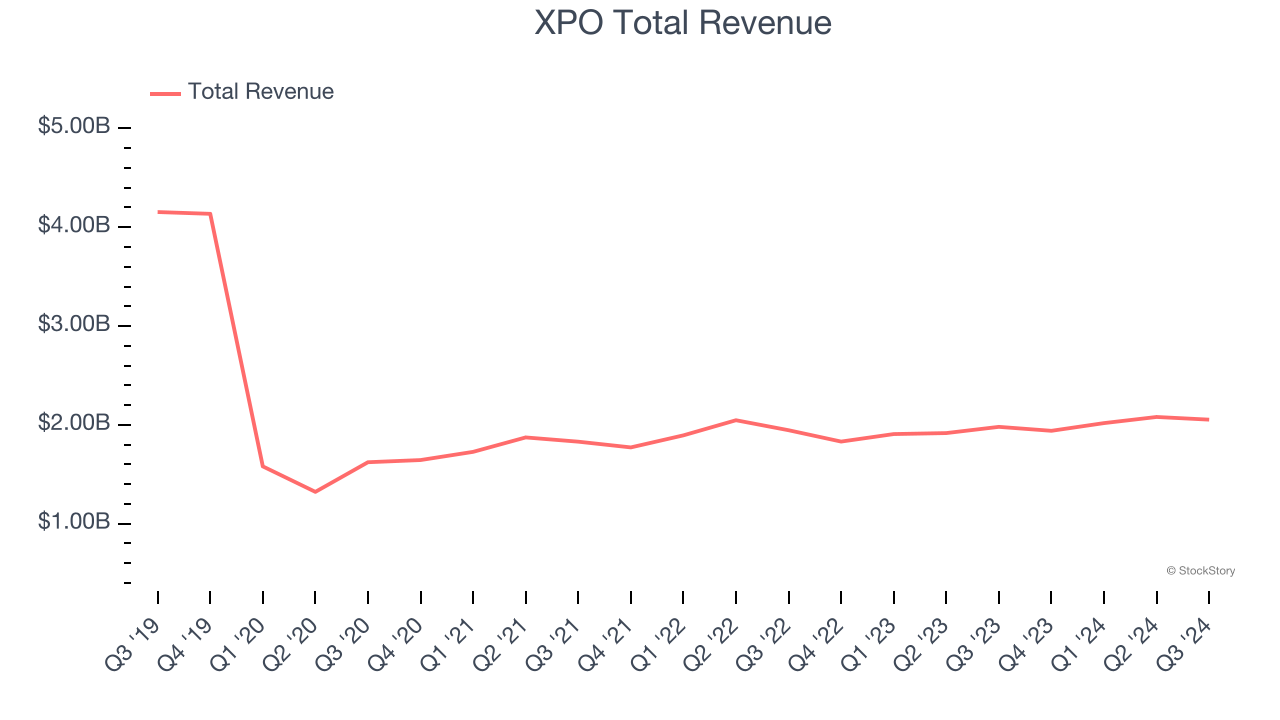
Quarterly earnings results are a good time to check in on a company’s progress, especially compared to its peers in the same sector. Today we are looking at Landstar (NASDAQ:LSTR) and the best and worst performers in the ground transportation industry.
The growth of e-commerce and global trade continues to drive demand for shipping services, especially last-mile delivery, presenting opportunities for ground transportation companies. The industry continues to invest in data, analytics, and autonomous fleets to optimize efficiency and find the most cost-effective routes. Despite the essential services this industry provides, ground transportation companies are still at the whim of economic cycles. Consumer spending, for example, can greatly impact the demand for these companies’ offerings while fuel costs can influence profit margins.
The 16 ground transportation stocks we track reported a softer Q3. As a group, revenues missed analysts’ consensus estimates by 1.9%.
While some ground transportation stocks have fared somewhat better than others, they have collectively declined. On average, share prices are down 3.1% since the latest earnings results.
Landstar (NASDAQ:LSTR)
Covering billions of miles throughout North America, Landstar (NASDAQ:LSTR) is a transportation company specializing in freight and last-mile delivery services.
Landstar reported revenues of $1.22 billion, down 5.8% year on year. This print was in line with analysts’ expectations, but overall, it was a softer quarter for the company with a miss of analysts’ adjusted operating income estimates.

Unsurprisingly, the stock is down 8.2% since reporting and currently trades at $165.59.
Read our full report on Landstar here, it’s free.
Best Q3: XPO (NYSE:XPO)
Owning a mobile game simulating freight operations for the Tour de France, XPO (NYSE:XPO) is a transportation company specializing in expedited shipping services.
XPO reported revenues of $2.05 billion, up 3.7% year on year, outperforming analysts’ expectations by 1.8%. The business had a very strong quarter with a solid beat of analysts’ EBITDA estimates.

XPO pulled off the biggest analyst estimates beat among its peers. The market seems happy with the results as the stock is up 11% since reporting. It currently trades at $133.54.
Is now the time to buy XPO? Access our full analysis of the earnings results here, it’s free.
Weakest Q3: Werner (NASDAQ:WERN)
Conducting business in over a 100 countries, Werner (NASDAQ:WERN) offers full-truckload, less-than-truckload, and intermodal delivery services.
Werner reported revenues of $745.7 million, down 8.8% year on year, falling short of analysts’ expectations by 2.6%. It was a disappointing quarter as it posted a significant miss of analysts’ adjusted operating income estimates.
As expected, the stock is down 11.8% since the results and currently trades at $33.74.
Read our full analysis of Werner’s results here.
Saia (NASDAQ:SAIA)
Pivoting its business model after realizing there was more success in delivering produce than selling it, Saia (NASDAQ:SAIA) is a provider of freight transportation solutions.
Saia reported revenues of $842.1 million, up 8.6% year on year. This print met analysts’ expectations. More broadly, it was a mixed quarter as it also recorded an impressive beat of analysts’ sales volume estimates but a miss of analysts’ EPS estimates.
Saia pulled off the fastest revenue growth among its peers. The stock is up 8.7% since reporting and currently trades at $449.91.
Read our full, actionable report on Saia here, it’s free.
Hertz (NASDAQ:HTZ)
Started with a dozen Model T Fords, Hertz (NASDAQ:HTZ) is a global car rental company providing vehicle rental services to leisure and business travelers.
Hertz reported revenues of $2.58 billion, down 4.7% year on year. This result came in 3.8% below analysts' expectations. Overall, it was a softer quarter as it also produced a significant miss of analysts’ adjusted operating income and EPS estimates.
The stock is up 11.3% since reporting and currently trades at $3.74.
Read our full, actionable report on Hertz here, it’s free.
Market Update
Thanks to the Fed's series of rate hikes in 2022 and 2023, inflation has cooled significantly from its post-pandemic highs, drawing closer to the 2% goal. This disinflation has occurred without severely impacting economic growth, suggesting the success of a soft landing. The stock market has thrived in 2024, spurred by recent rate cuts (0.5% in September and 0.25% each in November and December), and a notable surge followed Donald Trump's presidential election win in November, propelling indices to historic highs. Nonetheless, the outlook for 2025 remains clouded by the pace and magnitude of future rate cuts as well as potential changes in trade policy and corporate taxes once the Trump administration takes over. The path forward is marked by uncertainty.
Want to invest in winners with rock-solid fundamentals? Check out our Top 6 Stocks and add them to your watchlist. These companies are poised for growth regardless of the political or macroeconomic climate.
Join Paid Stock Investor Research
Help us make StockStory more helpful to investors like yourself. Join our paid user research session and receive a $50 Amazon gift card for your opinions. Sign up here.
